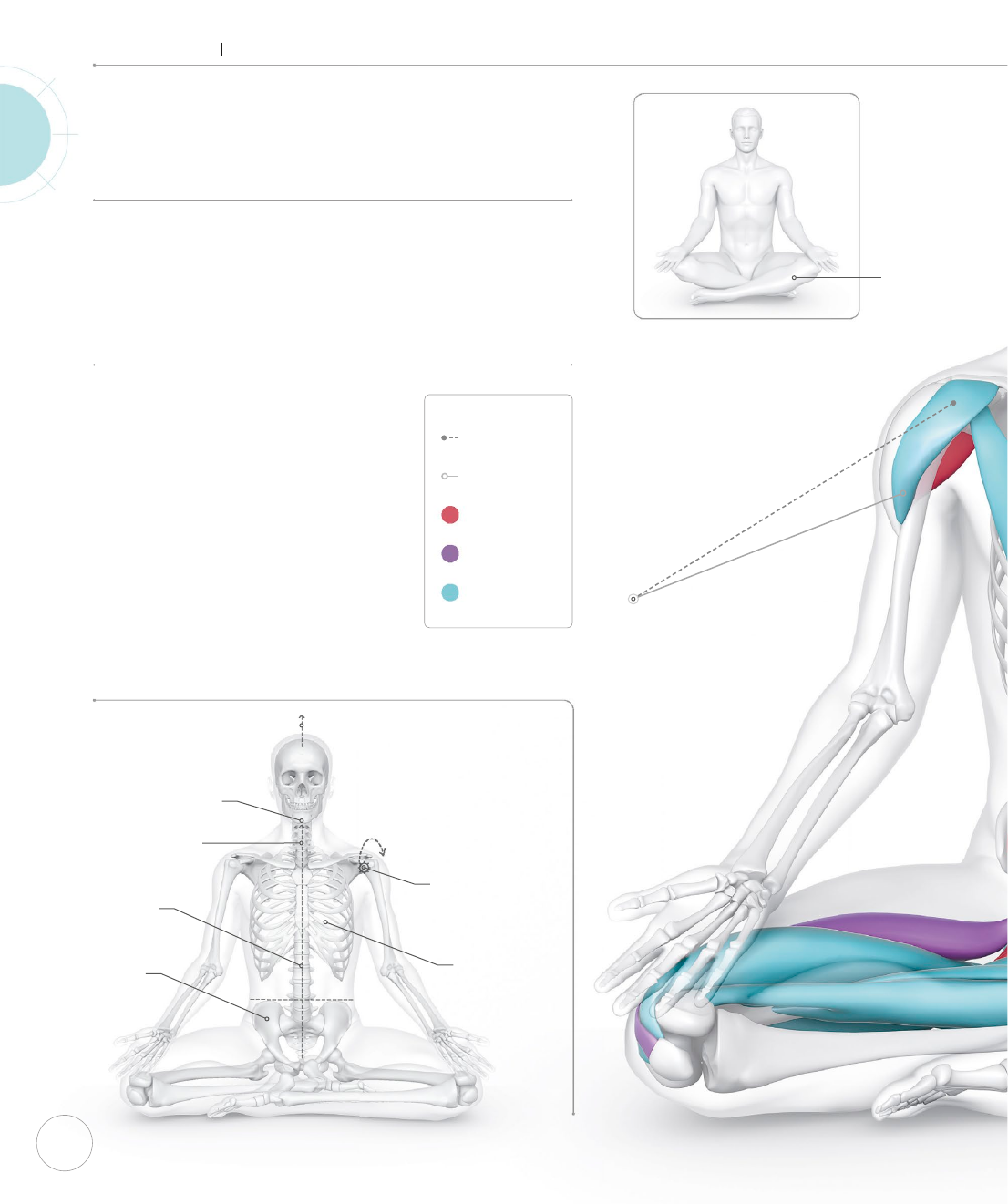
46
THE ASANAS
Seated
This seated pose is so called because the traditional
purpose of all the other poses is to prepare your body
physically for this meditative posture. The neutral spine
and engaged abdominals should make this pose steady
and comfortable; if it isn’t, try other options.
THE BIG PICTURE
Your back muscles and abdominals
engage, while stretching muscles on the
outside of your hips. You may feel this
minimally, but for many people it can
be challenging to maintain a neutral
spine and pelvis, using muscles in ways
your body isn’t used to.
ACCOMPLISHED
Siddhasana
Deltoids
Shoulder
VARIATION
The common variation Sukhasana,
or “easy pose,” has the legs crossing
at the shins. For many, this may not
be so “easy;” find support by sitting
on a prop to elevate your hips.
ALIGNMENT
Your spine is neutral, to hold
your weight most eciently.
Allow a sense of lightness in
your spine. Your shoulders
roll back, slightly pulling your
shoulder blades together.
Spine
neutral
Pelvis
neutral
Spine elongating
Chin parallel
to floor
Imagine your
head floating up
Chest broad
Shoulders
released back
and down
Arms
Your arms relax with the
palms of the hands facing up
(supinated). Your posterior
deltoid initiates external
shoulder rotation, while
your anterior deltoid
is slightly stretching.
Legs crossed
comfortably
KEY
Joints
Muscles
Engaging
Engaging while
stretching
Stretching
US_046-047_Accomplished_01.indd 46 20/09/2018 20:46

47
Thighs and lower legs
Your hip exors – mainly your
iliopsoas – help maintain
hip exion. You may feel
engagement of more thigh
muscles here; consider using
props until you can relax
unnecessary engagement.
Your quadriceps, gluteus
maximus, and hip adductors
are stretched. You may feel
stretching around your ankles,
which are in plantar exion.
Rhomboids
Iliacus
Psoas major
Pectineus
Hip
Gluteus maximus
Adductor longus
Adductor magnus
Vastus medialis
Vastus lateralis
Rectus femoris
Knee
Spine
Pectoralis minor
Spinal extensors
Latissimus dorsi
Rectus abdominis
Transversus abdominis
Splenius muscles
Trapezius
Torso
Your spinal extensors and
transversus abdominis
engage to lengthen and
stabilize your spine in a neutral
position, while your rectus
abdominis stretches slightly.
Your multidus engages,
sending feedback to your brain
about your body’s position. Your
rhomboids and middle and
lower trapezius engage slightly
to retract your scapulae, while
you consciously release any
tension held in your upper
trapezius. Your latissimus
dorsi and other back muscles
may be minimally engaged
to stabilize you in position.
Neck
To stabilize your cervical
spine in a natural curve, your
cervical extensor muscles—
your splenius capitis and
cervicis
—
engage while in a
neutral or slightly lengthening
position. Activate this by
imagining your head is as
light as a helium balloon.
Legs crossed
comfortably
US_046-047_Accomplished_01.indd 47 20/09/2018 20:46

48
Ribcage movement
As you inhale, your breastbone lifts while
your ribcage expands in all directions and
the diaphragm descends. As you exhale, your
breastbone and ribs return down and inward;
the diaphragm ascends to push out carbon
dioxide. Allow this movement as you breathe.
ACCOMPLISHED Siddhasana
CLOSER LOOK
In Accomplished pose, your
intervertebral disks are stacked on top
of each other, creating the natural
curves of the neutral spine. As you
breathe, your ribcage expands and
releases eciently, which is facilitated
by sitting tall with good posture.
Disk stacking
When your spine is in its natural
curvature—in a “neutral” position (see
p.14)—your vertebrae are stacked
and the gravitational load on your
intervertebral disks is evenly
distributed. Your disks are made of
squishy brocartilage, allowing your
spine to move dynamically.
Cervical extensor
muscles work to
lengthen spine
Ribcage
expands
Ribcage
contracts
Breastbone
lifts up and
outward
Diaphragm
contracts and
descends
Diaphragm
relaxes and
ascends
Breastbone
moves down
and inward
LATERAL VIEW
INHALE
EXHALE
Vertebrae
stack vertically
Intervertebral
disk
Hip joint is
rotated outward
US_048-049_Accomplished_02.indd 48 20/09/2018 20:46

49
Locked long rhomboids
If you slouch, your back muscles,
including your rhomboids, may
be “locked long.” When this
happens, your shoulder blades
spread forward and your
pectoralis minor muscles
shorten. Try rolling your shoulders
back to awaken your rhomboids.
This creates a muscular sling of
tension for ecient posture.
THE ASANAS Seated
Quadriceps
stretch
Head is light,
as if floating
upward
Enlongating your spine
“Axial extension” involves muscle
engagement to elongate the axial
skeleton (your spine, ribcage, and skull).
In many poses, this action counteracts
gravity and the tendency to slouch.
However, don’t lengthen so much that
you lose the natural spinal curves. Like
a stretched spring, these curves create
support and resilience.
Pectoralis
minor is
short
Trapezius
is long
Rhomboids
are long
Gravity
Neutral
spine
Spinal
extensors
Spine
Axial
extension
POSTERIOR VIEW
Gluteus maximus
stretches and relaxes
Middle and lower
trapezius engage
with rhomboids to
stabilize scapulae
US_048-049_Accomplished_02.indd 49 20/09/2018 20:46
..................Content has been hidden....................
You can't read the all page of ebook, please click here login for view all page.
